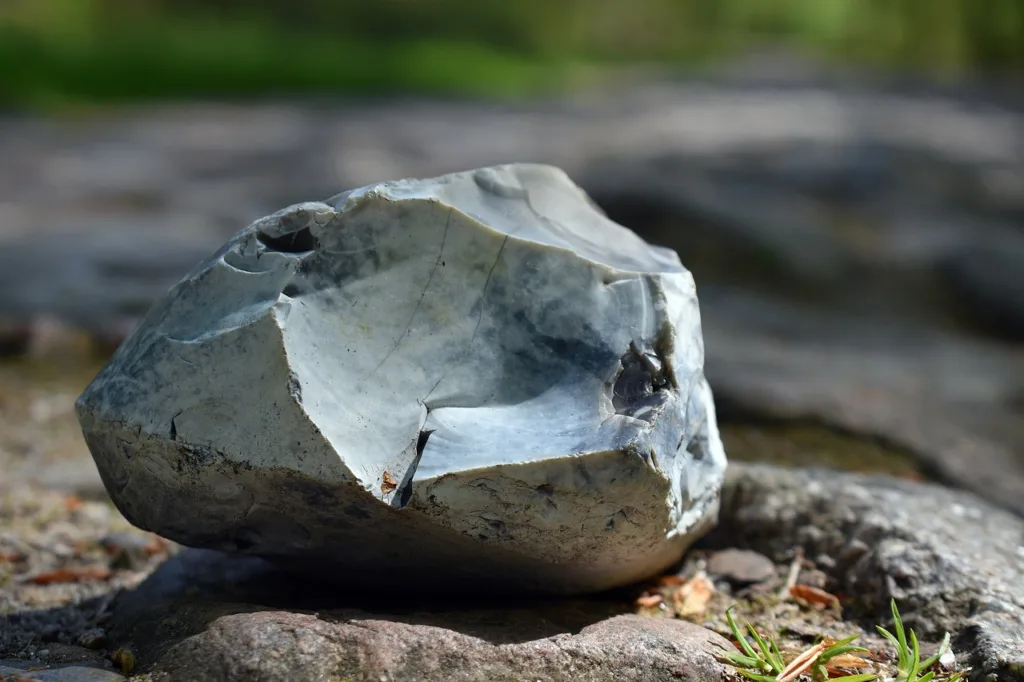Flints, also known as flint stones, are microcrystalline rocks composed primarily of silica. They have been used by various civilizations throughout history for a wide range of purposes. Native Americans, for instance, utilized Ohio flint to craft projectile points, including arrowheads and spearheads, as well as drills and other tools. Early European settlers, on the other hand, employed flint as buhrstones, or hard millstones, to grind grain.
The formation of flint is believed to have begun shortly after the deposition of Chalk, a type of limestone composed mainly of microscopic marine organisms. During the formation process, silica gradually replaces the original Chalk carbonate grain, one grain at a time. This replacement occurs through the dissolution of the carbonate, with silica then precipitating in its place. Initially, the silica takes the form of crystalline opal, but over time and with further burial, it transforms into quartz, which is what we commonly refer to as flint.
Today, the uses of flint are primarily ornamental, with its aesthetic appeal making it a popular choice for jewelry. The unique patterns and colors found in flint stones make them highly sought after by individuals looking for something distinctive and eye-catching. Whether used as pendants, beads, or inlaid into various accessories, flint adds a touch of natural beauty to any piece.
Another notable historical use of flint is in the flintlock mechanism, which revolutionized firearms during the early 16th century in Western Europe. A flintlock is a type of firearm that utilizes a flint-striking ignition mechanism. When the trigger is pulled, a hammer strikes a piece of flint against a steel plate, creating sparks that ignite the gunpowder and propel the bullet forward. This mechanism played a significant role in warfare and hunting for centuries before being replaced by more advanced firearms.
Flint is a microcrystalline rock composed primarily of silica. Its formation occurs through the gradual replacement of carbonate grains in Chalk, leading to the transformation into quartz over time. Throughout history, flint has been used by various civilizations for practical purposes, such as crafting tools and grinding grain. Today, its main use is ornamental, particularly in jewelry, where its unique patterns and colors add a touch of natural beauty. Additionally, flint played a pivotal role in the development of firearms, with the flintlock mechanism revolutionizing the way guns were ignited and fired.
What Are Flints Used For?
Flints have been used by Native Americans in Ohio for various purposes. These include making projectile points like arrow and spearheads, as well as drills and other tools. The sharp edges of flint make it an ideal material for creating these pointed and cutting implements.
In addition to its use by indigenous populations, early European settlers in Ohio also found value in flint. They used it as buhrstones, which are hard millstones used for grinding grain. The durability and hardness of flint made it an excellent choice for this purpose, allowing settlers to turn grain into flour for baking and cooking.
Although its practical uses have diminished over time, flint still holds significance today. It is primarily used in ornamental applications, especially in jewelry. The unique patterns and colors found in flint make it a popular choice for creating eye-catching pieces of adornment.
To summarize, flint has been historically utilized by Native Americans for making tools and by early European settlers as grinding stones. Presently, flint is primarily used for its aesthetic appeal, particularly in the creation of jewelry.

What Is Flint And How Is It Formed?
Flint is a type of rock that is composed of microcrystalline silica. It is believed to have started forming shortly after the deposition of Chalk, which is a type of carbonate rock. The formation of flint involves a gradual replacement of the original Chalk carbonate grain with silica, occurring grain by grain.
The process of flint formation begins with the dissolution of the Chalk carbonate. This dissolution is typically facilitated by water, which helps break down the carbonate material. As the carbonate is dissolved, silica is simultaneously precipitated and deposited in its place. This replacement of carbonate with silica occurs on a microscopic level, with each individual grain of Chalk being replaced by a grain of silica.
The silica that replaces the Chalk is in the form of microcrystalline quartz, which gives flint its characteristic hardness and durability. The deposition of silica continues over time, gradually transforming the Chalk into a solid mass of flint. This replacement process is thought to take place over millions of years, as the dissolution and precipitation occur slowly.
It’s important to note that flint is not only formed in association with Chalk, but it can also be found in other types of rocks, such as limestone and dolomite. However, the process of formation remains similar, with the silica replacing the original carbonate material.
Conclusion
Flint is a unique microcrystalline rock composed mainly of silica. It is formed through a gradual process of silica replacing the original carbonate grains of Chalk. This replacement occurs molecule by molecule, resulting in the transformation of crystalline opal into quartz, which is commonly known as flint.
Flint has played a significant role throughout history, particularly in the lives of Native Americans and early European settlers. Native Americans utilized flint to create various tools and weapons, such as arrowheads, spearheads, and drills. Meanwhile, European settlers used flint as buhrstones for grinding grains.
Today, flint is primarily valued for its ornamental purposes, often used in jewelry due to its unique and beautiful appearance. Furthermore, the term “flintlock” refers to a type of firearm that utilizes a flint-striking ignition mechanism, which first emerged in Western Europe during the 16th century.
Flint holds both historical and geological significance. Its formation process and versatile applications have contributed to its continued relevance and fascination among various cultures and industries.
